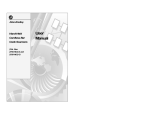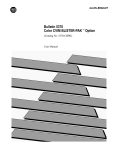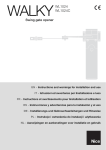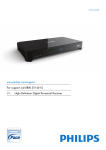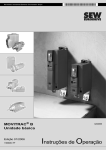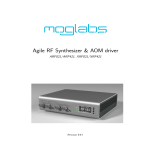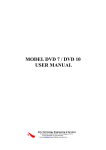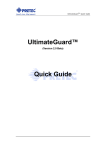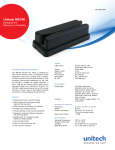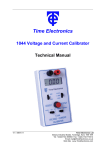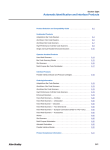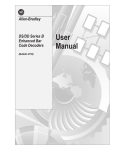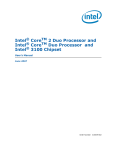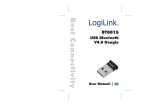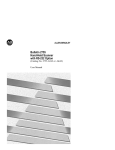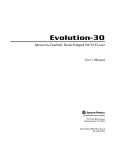Download 2755-6.1, Hand-Held Undecoded Bar Code Scanner User Manual
Transcript
Allen-Bradley Hand-Held Undecoded Bar Code Scanner Cat. No. 2755-HUG-4, 2755-HUG-9 User Manual Important User Information Because of the variety of uses for the products described in this publication, those responsible for the application and use of this control equipment must satisfy themselves that all necessary steps have been taken to assure that each application and use meets all performance and safety requirements, including any applicable laws, regulations, codes and standards. The illustrations, charts, sample programs and layout examples shown in this guide are intended solely for purposes of example. Since there are many variables and requirements associated with any particular installation, Allen-Bradley does not assume responsibility or liability (to include intellectual property liability) for actual use based upon the examples shown in this publication. Allen-Bradley publication SGI-1.1, Safety Guidelines for the Application, Installation, and Maintenance of Solid-State Control (available from your local Allen-Bradley office), describes some important differences between solid-state equipment and electromechanical devices that should be taken into consideration when applying products such as those described in this publication. Reproduction of the contents of this copyrighted publication, in whole or in part, without written permission of Allen-Bradley Company, Inc., is prohibited. Throughout this manual we use notes to make you aware of safety considerations: ! ATTENTION: Identifies information about practices or circumstances that can lead to personal injury or death, property damage or economic loss. Attention statements help you to: • identify a hazard • avoid the hazard • recognize the consequences Important: Identifies information that is critical for successful application and understanding of the product. Publication 2755-6.1 Table of Contents Preface Intended Audience . . . . . . . . . . . . . . . . . . . . . . . . . . . . . . . . . . Contents of this Manual . . . . . . . . . . . . . . . . . . . . . . . . . . . . . . . Related Publications . . . . . . . . . . . . . . . . . . . . . . . . . . . . . . . . . Laser Warning Symbol . . . . . . . . . . . . . . . . . . . . . . . . . . . . . . . . Chapter 1 Scanner Features Scanner Features . . . . . . . . . . . . . . . . . . . . . . . . . . . . . . . . . . . LED Indicators . . . . . . . . . . . . . . . . . . . . . . . . . . . . . . . . . . . . . Safety Labels . . . . . . . . . . . . . . . . . . . . . . . . . . . . . . . . . . . . . . Scanning Ranges . . . . . . . . . . . . . . . . . . . . . . . . . . . . . . . . . . . Standard Range Scanner (Catalog No. 2755-HUG-4) . . . . . . . . Extended Range Scanner (Catalog No. 2755-HUG-9) . . . . . . . Accessories . . . . . . . . . . . . . . . . . . . . . . . . . . . . . . . . . . . . . . . Chapter 2 P–1 P–2 P–3 P–3 1–2 1–3 1–4 1–5 1–6 1–7 1–8 Connecting and Operating Scanner Compatible Decoders . . . . . . . . . . . . . . . . . . . . . . . . . . . . . . . . Scanner Cable . . . . . . . . . . . . . . . . . . . . . . . . . . . . . . . . . . . . . Connecting the Scanner to a Decoder . . . . . . . . . . . . . . . . . . . . . Operating the Scanner . . . . . . . . . . . . . . . . . . . . . . . . . . . . . . . . Spotter Beam . . . . . . . . . . . . . . . . . . . . . . . . . . . . . . . . . . . . . . Automatic Shutoff . . . . . . . . . . . . . . . . . . . . . . . . . . . . . . . . . . . Audible Response . . . . . . . . . . . . . . . . . . . . . . . . . . . . . . . . . . . Operating Tips . . . . . . . . . . . . . . . . . . . . . . . . . . . . . . . . . . . . . Publication 2755-6.1 2–1 2–2 2–3 2–5 2–6 2–6 2–6 2–7 toc–ii Chapter 3 Troubleshooting and Maintenance Troubleshooting the Scanner . . . . . . . . . . . . . . . . . . . . . . . . . . . Cleaning the Scan Window . . . . . . . . . . . . . . . . . . . . . . . . . . . . Specifications Appendix A Connector Pinouts Appendix B European Union Directive Compliance Appendix C Glossary Publication 2755-6.1 3–2 3–4 Preface Using this Manual Read this preface to familiarize yourself with the rest of the manual. This preface covers the following topics: • • • • intended audience chapter contents laser warning symbol related publications Intended Audience No special knowledge is required to understand this document or to use the scanner. Undecoded scanners require a decoder. We assume that you are familiar with the operation and cable inputs to your decoder. Publication 2755-6.1 P–2 Contents of this Manual The following table briefly describes the contents of each section. Chapter Title Contents Preface Using this Manual Describes the purpose, background, and scope of this manual. Also provides a list of related publications. 1 Scanner Features Overview of the scanner. Includes read range charts and description of accessory items. 2 Connecting and Operating the Scanner Describes how to connect the scanner to a decoder. Operating tips are also provided. 3 Troubleshooting and Maintenance Provides solutions to the most common operating problems. Also includes instructions on cleaning the scan window. Appendix A Specifications Provides physical, electrical and environmental specifications. Appendix B Scanner Connector Pinouts Provides scanner pinout signal names and a brief description of each. Appendix C European Union Compliance Directives Lists requirements for use of scanner within the European Union. Provides definitions for commonly used terminology. Glossary Inside Back Cover Publication 2755-6.1 Bar Code Test Symbols Sample symbols useful for testing the operation of your bar code system. P–3 Related Publications Below is a list of related publications you may need to refer to when using the scanners. Publication No. Title 2755-921 Bar Code Basics Describes bar code symbologies, equipment, and typical applications. 2755-833 User Manual for DS/DD Series B Enhanced Decoders 2755-ND010 User Manual for Single-Head Enhanced Decoder (Catalog No. 2755-DS1A) 2755-ND011 User Manual for Dual-Head Enhanced Decoder (Catalog No. 2755-DD1A) 2755-2.37 Product Data Sheet for Bulletin 2755 Gun Adapter (Catalog No. 2755-NC16) Laser Warning Symbol Be aware of the following laser caution symbols. LASER LIGHT DO NOT STARE INTO BEAM CLASS 2 LASER PRODUCT 680nm LASER 1.0 MILLIWATT MAX OUTPUT RAYONNEMENT LASER NE PAS REGARDER DANS LE FAISCEAU APPAREIL A LASER DE CLASSE 2 LASER–STRAHLUNG NICHT IN DEN STRAHL BLICKEN ! LASER KLASSE 2 Publication 2755-6.1 Chapter 1 Scanner Features This chapter describes the features of the standard and extended range, undecoded scanners. Included are descriptions of: • major features • LEDs • scanning ranges • safety labels • accessories Publication 2755-6.1 1–2 Scanner Features The scanners use a low power visible (red) laser diode for scanning. The trigger turns on the laser which scans a label at approximately 36 scans per second. LEDs Trigger Cable Connector The laser beam: -exits through the scan window -reflects off the label back through the window -is detected by a sensor in the scanner When a label is read, the laser beam is automatically turned off until the trigger is pressed again. If no label is read, the laser beam automatically turns off after approximately 3 seconds and remains off until the trigger is released and pressed again. Note: The Extended Range Scanner (Catalog No. 2755-HUG-9) has a two position trigger. The first detent provides a spotter beam and the second position provides a scan line. Publication 2755-6.1 1–3 LED Indicators On the back of the scanner there is a clear window through which two LEDs are visible. Green Red Green LED = Good Read, indicating that a bar code symbol has been scanned and decoded. LED remains on until the next scan (trigger pressed). Red LED = Scanning, indicating that the laser light is on. Publication 2755-6.1 1–4 Safety Labels The scanners use a low power visible laser diode. As with any bright light source, you should avoid staring directly into the beam. Momentary exposure to a CDRH Class II laser is not known to be harmful. The following figure shows the location of all safety labels as they appear on the scanner. LASER LIGHT DO NOT STARE INTO BEAM CLASS 2 LASER PRODUCT 680nm LASER 1.0 MILLIWATT MAX OUTPUT AVOID EXPOSURE LASER LIGHT IS EMITTED FROM THIS APERATURE. Appears on both sides. RAYONNEMENT LASER NE PAS REGARDER DANS LE FAISCEAU APPAREIL A LASER DE CLASSE 2 LASER–STRAHLUNG NICHT IN DEN STRAHL BLICKEN ! LASER KLASSE 2 COMPLIES WITH IEC 825–1:1993/EN 60825 CAUTION – LASER LIGHT WHEN OPEN – DO NOT STARE INTO BEAM. ATTENTION – RAYONNEMENT LASER EN CAS DOUVERTURE. NE PAS REGARDER DANS LE FAISCEAU VORSICHT! LASERSTRAHL, WENN ABDECKUNG GEOEFFNET Publication 2755-6.1 1–5 Scanning Ranges The scanners can read bar code symbols at various distances depending upon the bar code symbol density (width of narrow bars or spaces). The following table lists the read ranges for both the standard and extended range scanners. Minimum Symbol Density Standard Range (Catalog No. 2755-HUG4) Inches / Centimeters Extended Range (Catalog No. 2755-HUG9) Inches / Meters 5.0 mil (.13 mm) 1.25 in to 2.7 in (3.2 cm to 6.9 cm) Not Applicable 7.5 mil (.19 mm) 1.0 in to 7.0 in (2.5 cm to 17.8 cm) 5.0 in to 11 in (0.13 m to 0.28 m) 10.0 mil (.25 mm) Data Not Available 4.0 to 13 in (0.10 m to 0.33 m) 15.0 mil (.38 mm) Data Not Available 4.0 to 60 in ( 0.10 m to 1.52 m) 20.0 mil (.51 mm) 1.0 in to 27 in (2.5 cm to 69 cm) 5.0 to 65 in (0.13 m to 1.65 m) 40.0 mil (1.02 mm) 4.5 in to 37 in (11.4 cm to 94 cm) 14 in to 120 in (0.36 m to 3.05 m) 55.0 mil (1.40 mm) 7 in to 50 in (17.8 cm to 127 cm) 24 in to 156 in (0.61 m cm to 3.96 m) 70.0 mil (1.78 mm) Reflective Not Applicable 96 in to 276 in 2.43 m to 7.01 m 100 mil (1.02 mm) Reflective Not Applicable 96 in to 420 in (2.44 m to 10.67 m) Publication 2755-6.1 1–6 Standard Range Scanner Catalog No. 2755-HUG4 10 (25.4 cm) Scan Width Scanner 7.5 mil (0.19 mm) 20 mil (0.51 mm) 40 mil (1.02 mm) 55 mil (1.40 mm) 0 10 25 15 38 20 51 25 64 30 76 Distance From Front of Scanner Publication 2755-6.1 0 5 (12.7 cm) 10 (25.4 cm) 5 mil (0.13 mm) 5 inches centimeters 12.7 5 (12.7 cm) 35 89 40 102 50 127 1–7 Extended Range Scanner Catalog No. 2755-HUG9 50 in (127 cm) Scan Width See Inset Scanner 25 in (63.5 cm) 0 25 in (63.5 cm) 50 in (127 cm) 15.0 mil (0.38 mm) 20.0 mil (0.51mm) 40 mil (1.02 mm) 55.0 mil (1.40 mm) 70.0 mil Reflective (1.78 mm) 100 mil Reflective (2.54 mm) 0 inches centimeters 50 127 100 254 150 381 200 508 250 635 300 762 350 889 420 1067 Distance From Front of Scanner Inset 3 in (7.8cm) Scan Width 1.5 in (3.8 mm) 0 1.5 in (3.8 mm) 3 in (7.8cm) 7.5 mil (.19 mm) 10 mil (0.25 mm) 0 inches centimeters 3 7.6 6 15.2 9 22.9 11 27.9 13 33.0 Publication 2755-6.1 1–8 Accessories The following accessories are available. Scanner Cables – Connect scanner to A-B decoder. See page 2–2 for connections. • 8 ft. / 2.44 meter (Catalog No. 2755-HUC-GA1-08) • 15 ft. / 4.57 meter (Catalog No. 2755-HUC-GA1-15) • 20 ft. / 6.1 meter (Catalog No. 2755-HUC-GA1-20) Adjustable Stands – Holds scanner at adjustable angles and heights for hand-free scanner operation. • 5 to 18 inch (127 to 457 mm) height (Catalog No. 2755-HFN-K1) • 9 to 16 inch (229 to 406 mm) height (Catalog No. 2755-HFN-K2) Multi-mount Stand – Rubber-coated, fixed mount holder for counter or wall mounting. • (Catalog No. 2755-HFN-K3) Protective Boot – Heavy canvas boot provides additional protection for the scanner. • (Catalog No. 2755-HFN-H1) Publication 2755-6.1 Chapter 2 Connecting and Operating Scanner This chapter describes how to connect and test the operation of the scanner. Sections include: • compatible decoding devices • installing / removing the interface cable • connecting to a decoder • operating scanner Safety ! ATTENTION: Caution - use of controls or adjustments or performance of procedures other than those specified herein may result in hazardous laser light exposure. Compatible Decoders The undecoded scanners are compatible with the following Allen-Bradley decoders: • Bulletin 2708-DH5 Attended Workstations • Multi-Purpose Bar Code WorkStation (Catalog No. 2755-DH1) • Single or Dual-Head Enhanced Bar Code Decoder (Catalog No. 2755-DD1x, -DS1x) Publication 2755-6.1 2–2 Scanner Cable The scanner cables connect to the bottom of the scanner handle. See page 1–8 for lengths available. Slot for Locking Collar Connector Locking Collar Cable Connector To attach the scanner cable to the scanner. 1. Pull back the locking collar from the connector. 2. Insert the cable connector into the scanner. 3. Align the tabs on the locking collar with the slots on the handle. 4. Push in and turn the locking collar counterclockwise to lock. Connector is locked when flat edge of locking collar aligns with the flat edge of the scanner handle. Remove a scanner cable by rotating the locking collar clockwise until the cable can be pulled out of the scanner. Publication 2755-6.1 2–3 Connecting the Scanner to a Decoder The scanner interface cable connects to the input port of the decoder. The following table summarizes the cable and connectors required for each decoder. Note: A Gun Adapter (Catalog No. 2755-NC16) may be required to connect the scanner to some Series B decoders. Decoder Type ! ! 2755-NC16 Series B Gun Adapter Bulletin 2708-DH5 Attended WorkStations No Multi-Purpose Bar Code WorkStation (Catalog No. 2755-DH1) No Single or Dual-Head Enhanced Bar Code Decoder (Catalog No. 2755-DS1A, -DD1A) Required ATTENTION: Do not install or remove the scanner cables or connectors until the power to the scanner and decoder is turned off. Failure to follow this caution may result in damage to the scanner or decoder. ATTENTION: Make sure you use the Series B Gun Adapter (Catalog No. 2755-NC16, Series B). If you are ugrading from an earlier version Allen-Bradley hand-held scanner (such as the 2755-G2 or -G3) which used the Series A gun adapter, you will need to purchase the series B gun adapter. Publication 2755-6.1 2–4 The 2755-NC16 Gun Adapter connects to the decoder input port as shown below for the Enhanced Decoder, the High Speed Decoder is similar. Gun Adapter Publication 2755-6.1 2–5 Operating the Scanner 1. Check your connections. • Is the scanner cable securely attached? • If connecting to a High Speed or Enhanced decoder, is the Gun Adapter present? • Is power applied to the decoder? 2. Test the scanner Aim the scanner at the work surface and press the trigger. You should see the red beam on the work surface, and the red LED on the back of the scanner should be on. 3. Scan a label. Scan a bar code. Adjust the scanner position so that the scan beam is centered on the bar code and overlaps both sides. When the scanner has read a symbol: • You will hear a beep from the decoder (if enabled). • The green LED will turn on and remain on until the next scan. Publication 2755-6.1 2–6 Spotter Beam The Extended Range Scanner (Catalog No. 2755-HUG-9) has a two position trigger. The first detent turns on a spotter beam. Center the spotter beam over the center of the symbol or press the trigger all the way to start the scan beam. Correct Incorrect Automatic Shutoff The scanner will automatically stop scanning after a bar code symbol has been read. If no symbol is decoded, the scanner will automatically stop after approximately 4 seconds. You must release and press the trigger again to resume scanning. Audible Response When scanning a bar code symbol, listen for a single short beep from the decoder. This beep indicates that the bar code has been successfully scanned. Some decoders cannot provide an audible response. Note: You will not hear an audible response if you are using the scanner with Allen-Bradley unattended decoders (Catalog No. 2755-DS1x, -DD1x). Publication 2755-6.1 2–7 Operating Tips Scan Symbols at an Angle Do not hold the scanner directly perpendicular to the symbol being scanned. Hold the scanner at a slight angle. Scan the Entire Symbol Hold the scanner so that the scan beam crosses the entire symbol. Correct Incorrect Also as general rule: • the larger the symbol, the farther away you should hold the scanner. • hold the scanner closer for symbols that have bars that are close together. Publication 2755-6.1 Chapter 3 Troubleshooting and Maintenance This chapter describes how to troubleshoot and maintain the scanner. • troubleshooting chart • cleaning the scan window • Allen-Bradley Global Technical Support Publication 2755-6.1 3–2 Troubleshooting the Scanner This section provides a list of the most common operating problems, the probable causes, and suggested corrective actions. Problem No Scan Beam. Probable Cause(s) 1. Decoder not on. 1. Verify that decoder is on. 2. Scan beam has timed out. 2. Normal operation. Release trigger completely and scan again. 3. Defective scanner cable. 3. If possible, try another scanner cable. 4. Defective scanner. 4. If possible, try another scanner using the same connections. Contact Allen-Bradley Global Support (GTS). 1. Trigger on Extended Range Scanner is not fully pressed. 1. Extended Range Scanner has a 2 position trigger. The first position is for the spotter beam. Press the trigger to the next position for scanning. 2. Defective scanner. 2. Contact Allen-Bradley Global Technical Support. Scan Beam Appears as a Dot Not a line Publication 2755-6.1 Corrective Action 3–3 Problem Scan Beam Present, Symbols Not Read Probable Cause(s) Corrective Action 1. Scanner not held at slight angle to symbol. 1. Hold scanner at an angle to the symbol. 2. Scan beam not crossing entire symbol. 2. Make sure scan beam crosses every bar or space on the symbol. 3. Decoder not programmed to read the type of bar code you are scanning. 3. Make sure the decoder is configured for the type of bar code symbols you are scanning. 4. Poor quality bar code symbols. 4. Use the symbols provided on the inside back cover for testing. 5. Loose cable connections. 5. Check for loose cable connections. 6. Gun adapter not being used. 6. If you are connecting the scanner to a High Speed or Enhanced decoder, you must use a Gun Adapter (Catalog No. 2755-NC16, Series B). Publication 2755-6.1 3–4 Cleaning the Scan Window You may need to clean the window of the scanner. Carefully clean the window by first removing loose particles of dirt with clean air. Then use an optical quality cloth moistened with an optical quality cleaning fluid for plastic lenses and wipe the window in a single direction (don’t wipe cloth back and forth across window). Do not leave streaks. ! ! ATTENTION: Do not use abrasive materials such as disposable wipes and facial tissue. Do not use solvents like alcohol or acetone. These materials will damage the window or the finish on the scanner. ATTENTION: The scanner has no serviceable parts. Do not open the housing of the scanner. A-B Technical Support If you should require assistance or need additional information on operating the scanner or Allen-Bradley decoder, contact Allen-Bradley Global Technical Services (GTS) at (216) 646-6800. Publication 2755-6.1 Appendix A Specifications Optical Nominal Scan Rate . . . . . . . . . . . Wavelength (nominal) . . . . . . . . . Maximum Roll (Skew) -HUG-4 . . . . . . . . . . . . . . . . -HUG-9 . . . . . . . . . . . . . . . . Maximum Pitch -HUG-4 . . . . . . . . . . . . . . . . -HUG-9 . . . . . . . . . . . . . . . . Depth of Field . . . . . . . . . . . . . . . Print Contrast (Minimum) . . . . . . . Ambient Light Immunity Incandescent . . . . . . . . . . . . Fluorescent . . . . . . . . . . . . . Sodium Vapor . . . . . . . . . . . Mercury Vapor . . . . . . . . . . . 33 to 39 scans/second 675 nm (Visible Red) 40_ from normal 10_ from normal 55_ from normal 45_ from normal See page 1-5 50% absolute dark/light differential 350 ft. candles (3766 lux) 450 ft. candles (4844 lux) 350 ft. candles (3766 lux) 450 ft. candles (4844 lux) Electrical Supply Voltage . . . . . . . . . . . . . . 4.8 to 14.0V DC Current . . . . . . . . . . . . . . . . . . . . 110 mA at 5V DC (typical) Mechanical Dimensions Inches . . . . . . . . . . . . . . . . . 5.0 (L) x 2.8 (W) x 6.3 (H) Millimeters . . . . . . . . . . . . . . 127 (L) x 71 (W) x 160 (H) Weight . . . . . . . . . . . . . . . . . . . . 8.5 oz (240 g) Publication 2755-6.1 A–2 Specifications Environmental Operating Temperature . . . . . . . . Storage Temperature . . . . . . . . . . Humidity . . . . . . . . . . . . . . . . . . . Drop Test . . . . . . . . . . . . . . . . . . -22_ to 122_F (-30_ to 50_C) -40_ to 140_F (-40_ to 60_C) 5% to 95% (noncondensing) 6ft (1.8 meter) to concrete Laser Certifications CDRH . . . . . . . . . . . . . . . . . . . . Class II laser product IEC 825 . . . . . . . . . . . . . . . . . . . Class 2 Agency Certifications UL and CUL Listed CE marked for all applicable directives Publication 2755-6.1 Appendix B Scanner Pinout Connections Pin #1 Pin #10 Pin Signal Name 1, 2 Power Function Power input (4.8 to 14V DC). 3 Ground Power and signal ground. 4 Enable Signal input to power-up the scanner, turn on the laser, turn on scanning motor. 5 Start of Scan Sychronizes decode logic with the scanner. 6 Trigger Switch Connected to trigger switch. This output is grounded when the switch is pressed. 7 Decode LED Controls green decode LED. 8 Digitized Bar Pattern Output provides a series of pulses proportional to the widths of the bar code being scanned. 9 Motor Fail 10 Not Used Powers down laser if scan motor fails. Publication 2755-6.1 Appendix C European Union Directive Compliance If the Hand Held Undecoded Scanner is installed within the European Union or EEA regions and has the CE mark, the following regulations apply. EMC Directive Undecoded Hand-Held Bar Code Scanners This apparatus is tested to meet EMC Directive 89/336/EEC and Low Voltage Directive 73/23/EEC using the following standards, in whole or in part: • EN 55 022 : 1988 • EN 50 082-1 : 1992 IEC 801.2 : 1988 IEC 801.3 : 1988 IEC 801.4 : 1988 • EN 60 950 : 1992 + A1:1993 + A2:1993 • EN 60 825-1 : 1994 The product described is intended for use in an industrial environment. Declarations of Conformity A copy of the Declaration of Conformity is provided on the next page. This document declares that the scanners conform to the applicable directives. Publication 2755-6.1 C-2 Publication 2755-6.1 Glossary A ASCII American Standard Code for Information Interchange. A 7 bit-plus-parity code representing 128 letters, numerals, punctuation marks, and control characters. It is a standard data transmission code in the U.S. B Bit Binary digit. One bit is the basic unit of binary information. Generally, eight consecutive bits compose one byte of data. The pattern of 0 and 1 values within the byte determines its meaning. Byte On an addressable boundary, eight adjacent binary digits (0 and 1) combined in a pattern to represent a specific character or numeric value. Bits are numbered from the right, 0 through 7, with bit 0 the low-order bit. One byte in memory can be used to store one ASCII character. C CDRH Center for Devices and Radiological Health. A federal agency responsible for regulating laser product safety. This agency specifies various laser operation classes based on power output during operation. Check Digit A digit used to verify a correct symbol decode. The scanner inserts the decoded data into an arithmetic formula and checks that the resulting number matches the encoded check digit. Check digits are required for UPC but are optional for other symbologies. Using check digits decreases the chance of substitution errors when a symbol is decoded. Publication 2755-6.1 G–2 Codabar A discrete self-checking code with a character set consisting of digits 0 to 9 and six additional characters: (- $ : / , +). Code 128 A high density symbology which allows the controller to encode all 128 ASCII characters without adding extra symbol elements. Code 3 of 9 (Code 39) A versatile and widely used alphanumeric bar code symbology with a set of 43 character types, including all uppercase letters, numerals from 0 to 9, and 7 special characters (- . / + % $ and space). The code name is derived from the fact that 3 of 9 elements representing a character are wide, while the remaining 6 are narrow. Code 93 An industrial symbology compatible with Code 39 but offering a full character ASCII set and a higher coding density than Code 39. Continuous Code A bar code or symbol in which all spaces within the symbol are parts of characters. There are no intercharacter gaps in a continuous code. The absence of gaps allows for greater information density. Publication 2755-6.1 G–3 D Decode To recognize a bar code symbology (e.g., UPC/EAN) and then analyze the content of the specific bar code scanned. Decode Algorithm A decoding scheme that converts pulse widths into data representation of the letters or numbers encoded within a bar code symbol. Discrete Code A bar code or symbol in which the spaces between characters (intercharacter gaps) are not part of the code. Discrete 2 of 5 A binary bar code symbology representing each character by a group of five bars, two of which are wide. The location of wide bars in the group determines which character is encoded; spaces are insignificant. Only numeric characters (0 to 9) and START/STOP characters may be encoded. E EAN European Article Number. This European/International version of the UPC provides its own coding format and symbology standards. Element dimensions are specified metrically. EAN is used primarily in retail. H Host Computer A computer that serves other terminals in a network, providing such services as computation, database access, supervisory programs, and network control. Publication 2755-6.1 G–4 I IEC International Electrotechnical Commission. This international agency regulates laser safety by specifying various laser operation classes based on power output during operation. Intercharacter Gap The space between two adjacent bar code characters in a discrete code. Interleaved Bar Code A bar code in which characters are paired together, using bars to represents the first character and the intervening spaces to represent the second. Interleaved 2 of 5 A binary bar code symbology representing character pairs in groups of five bars and five interleaved spaces. Interleaving provides for greater information density. The location of wide elements (bar/spaces) within each group determines which characters are encoded. This continuous code type uses no intercharacter spaces. Only numeric (0 to 9) and START / STOP characters may be encoded. Publication 2755-6.1 G–5 L Laser An acronym for Light Amplification by Stimulated Emission of Radiation. The laser is an intense light source. Light from a laser is all the same frequency, unlike the output of an incandescent bulb. Laser light is typically coherent and has a high energy density. Laser Diode A gallium-arsenide semiconductor type of laser connected to a power source to generate a laser beam. This laser type is a compact source of coherent light. P Parameter A variable that can have different values assigned to it. Programming Mode The state in which a scanner is configured for parameter values. See SCANNING MODE. Q Quiet Zone A clear space, containing no dark marks, which precedes the start character of a bar code symbol and follows the stop character. Publication 2755-6.1 G–6 S Scanner An electronic device used to scan bar code symbols and produce a digitized pattern that corresponds to the bars and spaces of the symbol. Its three main components are: 1. Light source (laser or photoelectric cell) - illuminates a bar code. 2. Photodetector - registers the difference in reflected light (more light reflected from spaces). 3. Signal conditioning circuit - transforms optical detector output into a digitized bar pattern. Scanning Mode The scanner is energized, programmed, and ready to read a bar code. Scanning Sequence A method of programming or configuring parameters for a bar code reading system by scanning bar code menus. Self Checking Code A symbology that uses a checking algorithm to detect encoding errors within the characters of a bar code symbol. Start / Stop Character A pattern of bars and spaces that provides the scanner with start and stop reading instructions and scanning direction. The start and stop characters are normally to the left and right margins of a horizontal code. Symbol A scannable unit that encodes data within the conventions of a certain symbology, usually including start/stop characters, quiet zones, data characters, and check characters. Symbology The structural rules and conventions for representing data within a particular bar code type (e.g. UPC/EAN, Code 39). Publication 2755-6.1 G–7 U UPC Universal Product Code. A relatively complex numeric symbology. Each character consists of two bars and two spaces, each of which can be any of four widths. The standard symbology for retail food packages in the United States. Publication 2755-6.1 Index A Accessories Protective Boot, 1-8 Scanner Cable, 1-8 Stands, 1-8 Audience, Intended, P-1 G Global Technical Support, 3-4 Gun Adapter, 2-3 L Label, Scanning, 2-5 B Boot, Protective, 1-8 C Cable, Scanner, 2-2 Certifications, A-2 Laser Certifications, A-2 Warning Label, 1-4 Warning Symbol, P-3 LEDs Good Read, 1-3 Location, 1-2 Red, 1-3 Cleaning, 3-4 Contents, Manual, P-2 M Mechanical Specifications, A-1 D Decoders, 2-1 Compatible, 2-1 Connecting, 2-3 Supported, 2-3 E O Operation, 2-5 Optical Specifications, A-1 P Electrical Specifications, A-1 Protective Boot, 1-8 Environmental Specifications, A-2 Publication, Related, P-3 F Features, 1-2 Publication 2755-6.1 I-2 R Read Range Extended Range Scanner, 1-7 Standard Scanner, 1-6 Read Ranges, 1-5 Related Publications, P-3 S Scanner Cable, 1-8, 2-2 Cleaning, 3-4 Features, 1-2 Operating, 2-5 Pinout Connections, B-1 Testing, 2-5 Troubleshooting, 3-2 Scanner , Read Ranges, 1-5 Scanning Labels, 2-5 Tips, 2-7 Specifications Electrical, A-1 Environmental, A-2 Mechanical, A-1 Optical, A-1 Stands, Standard and Adjustable, 1-8 Support, GTS, 3-4 Publication 2755-6.1 T Technical Support, GTS, 3-4 Telephone No., Technical Support, 3-4 Testing, 2-5 Troubleshooting, 3-2 W Warning Laser Light, P-3 Safety Label, 1-4 TEST SYMBOLS 1 2 3 4 5 1 2 3 4 5 Code 128 Code 93 A 1 2 3 4 B Codabar A 1 2 3 4 B Code 39 1 2 3 4 5 Discrete 2 of 5 1 2 3 4 5 EAN 128 1 234567 891019 EAN 13 1234 5670 EAN 8 0 1 23 4 5 Interleaved 2 of 5 1 23456 78901 UPC A 0 123456 UPC E 5 2 Worldwide representation. Argentina • Australia • Austria • Bahrain • Belgium • Brazil • Bulgaria • Canada • Chile • China, PRC • Colombia • Costa Rica • Croatia • Cyprus • Czech Republic • Denmark • Ecuador • Egypt • El Salvador • Finland • France • Germany • Greece • Guatemala • Honduras • Hong Kong • Hungary • Iceland • India • Indonesia • Ireland • Israel • Italy • Jamaica • Japan • Jordan • Korea • Kuwait • Lebanon • Malaysia • Mexico • Netherlands • New Zealand • Norway • Pakistan • Peru • Philippines • Poland • Portugal • Puerto Rico • Qatar • Romania • Russia–CIS • Saudi Arabia • Singapore • Slovakia • Slovenia • South Africa, Republic • Spain • Sweden • Switzerland • Taiwan • Thailand • Turkey • United Arab Emirates • United Kingdom • United States • Uruguay • Venezuela • Yugoslavia Allen-Bradley Headquarters, 1201 South Second Street, Milwaukee, WI 53204 USA, Tel: (1) 414 382-2000 Fax: (1) 414 382-4444 Publication 2755-6.1 – November 1996 Supercedes Publication 2755-6.1 August 1996 October 1995 40062-328-01(B) Copyright 1996 Allen-Bradley Company, Inc. Printed in USA 1784-6.5.19-RN1











































